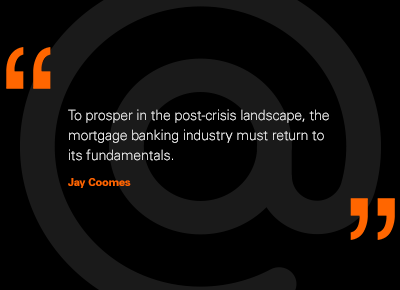

The Point
Secret to Profitability Is a Return to Mortgage Banking Roots
The legacy of the financial crisis for mortgage banking — beginning with the unexpected surge in default volumes and complex loss mitigation solutions, and culminating in Consumer Financial Protection Bureau (CFPB) audits and the TILA-RESPA Integrated Disclosure requirements — threatens to continue the rapid decline in profitability within the industry.
Operations which had been running smoothly became ineffective when the crisis hit. Now that the industry has stabilized, the challenge is to adjust operating models accordingly. We must re-examine — and resettle — now-excessive controls to regain our economic viability. Here are five areas ripe for re-examination:
Duplicate Operations and Reviews
If it isn't already the top priority, finding ways to reduce compliance costs without cutting corners must top every executive's list. Determine the control functions, as well as their audits and quality control checks, which have the highest cost. Consider reducing the quality control check to one based on statistically sound sampling. With a feedback mechanism, performance can be improved for less.
In the last few years, many legal and compliance teams have become separate functions, managed individually. Given that legal and compliance go hand-in-hand, this is a plum opportunity for consolidation.
Consumer-Friendly Policies
To prosper, our industry must be borrower-centric. Many organizations have become so concerned about regulatory violations that they are checking documents repeatedly. This is inefficient and costly, and lengthens the time between application, answer and closing. Mortgage bankers also need to anticipate consumers' questions by clearly giving the reasons for payment increases, and restructure customer operations, so that the contact person can solve problems, rather than take orders.
Technology Adoption
Seek technology that can automate manual steps. Optical Character Recognition (OCR), for example, can identify hundreds of documents and extract critical information from them. Marrying OCR to advanced workflow technology promises to change the mortgage origination game. For example, supporting documents are requested from the customer before the loan is sent to underwriting. Those documents need to be audited to ensure they contain the information required.
Similar technology could be used to further reduce potential losses, by determining if the initial TRID disclosure information remains within tolerances, and/or helping to ensure that the collaboration between lender and settlement agent yields consistent and accurate fees prior to disclosure. Such data audits could dramatically lessen, if not eliminate, the frequency of surprise redisclosures occurring just before closing which presently result in three- to seven-day closing delays.
If this technology is applied, the present manual audit is converted to a largely automated process where documents are scanned for confirmation of completeness. Some workflow programs also have the ability to ensure all required documents have been returned by the customer. The OCR engine can select the final version of a document based on key characteristics in the document, which is not only important for underwriting but also for closing and servicing.
In one consultative study, it was calculated that an organization with 6,000 loan originations per month would save more than $6.5 million per year.
Operational Performance
The productivity rewards for effective performance management can be significant. Recognizing high-performing employees for their efforts with rewards such as gas cards or "sunshine passes," which allow employees to shorten their day by a few hours, often have as much impact as a cash bonus. For underperforming staff, a little coaching can go a long way. Support for underperformers, given in concert with the management team receiving training to reinforce consistency and coach in a constructive way, can keep morale buoyed amid changes.
High performers should be the yardstick for standards, making them attainable and raising the bar for all employees. To determine who performs best, follow the 80/20 rule. Capture 80 percent of the work done. If it is being performed well, the chances are the rest of their work is, too.
Revamp Processes
The Mortgage Bankers Association announced in its third-quarter 2015 survey that delinquency rates had fallen 86 basis points below those from 2014. Staffing increases were required to handle delinquencies during the crisis, but as rates drop existing functions can be integrated.
When the Home Affordable Modification Program was initiated, loss mitigation areas were divided into units handling application processing, underwriting and fulfillment. Now, a single point of contact can handle collection calls and loss mitigation processing. By empowering this employee with adequate training, lenders can reduce operating costs and one of the major CFPB friction points — providing the customer with a single point of contact to guide them through the loss mitigation process — while improving the customer experience.
The mortgage industry's workforce should evolve as foreclosure rates continue to decline. While this may mean some positions in servicing need to be combined, current employees now have some unique experiences in handling loans with specialty processing needs such as loss mitigation. These employees should be more easily retrained as processors, funders or move into other servicing positions as normal turnover occurs. This not only helps offset any job losses, but has the advantage of redeploying talented existing staff that are already familiar and aligned with a particular company culture.
To prosper in the post-crisis landscape, the mortgage banking industry must return to its fundamentals. Developing a proactive set of initiatives like those described above would address regulatory concerns and allow for greater flexibility and growth as the industry continues to transform.
Reprinted with permission from National Mortgage News.
